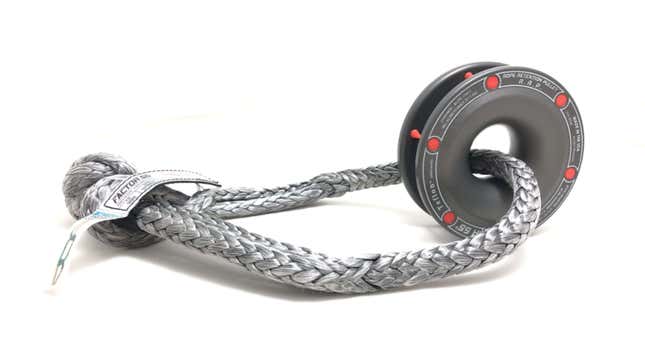I’ve been doing a fair amount of winch research lately, and one thing I’ve always kind of wondered about is winching your truck backwards with front-mounted winch. Do you just kind of sling the cable underneath and start winching?
It turns out, yeah, you can do that. But as Mad Matt from the Mad Matt 4WD YouTube channel explains, it’s kind of a last-resort deal. When you thread your little synthetic line or cable under your car it starts at the fairlead (the little mouth thing your line comes out of) where it has to take a 90 degree turn straight downward then on to probably your bumper, your front axle, rear axle, any sharp rocks. There are a whole bunch of things down there that you’d probably be better off not running a cable/line over when its under a lot of tension. That and there’s a good possibility of damaging your truck.
Short of mounting your winch on a trailer hitch and bringing it around the back of the truck, what’s the “correct” way to winch yourself backwards? I don’t know! But I’m going to show you one that might not pass the eyeball test at first, but makes sense when you think about it. It involves some pulleys that are actually not pulleys, but snatch blocks.
Snatch blocks are like pulleys, but their halves rotate so you can get your rope in there without threading it through as you would with an actual pulley.

There are also rope-retention rings, or ring blocks, whatever you want to call them. When paired with a soft shackle (the little ropey guy below), it becomes a nice little pulley.

To get the car to travel backward using the front mounted-winch, you have to create enough mechanical advantage so that the force of the winch cable pulling from behind overcomes the force of the winch cable pulling on the front. Check out this video, courtesy the world’s leading exporter of winch content: Australia. In this case it’s Robert Pepper:
Pepper carefully routes the rope around the truck and creates a sort of block and tackle situation behind it. He’s getting more pulling force at the back of the truck than at the front, which pulls him backwards and out of whatever trouble he found himself in.

Pepper is essentially using the power of the winch to take the slack out of the system, and because of the multiple blocks at the back, that’s easier to do back there than at the front.
If it’s still not clear, just imagine the vehicle in the diagram above moving rearward one foot under its own power. The distance between the two anchor points and the pulley at the back of the vehicle has gotten one foot smaller, feeding more winch cable to the front pulley. How much more cable? Well, there’s now one foot more slack between anchor one and the vehicle, and there’s another foot of slack between anchor two and the vehicle. That’s two feet of slack. Yes, the front of the vehicle has also moved rearward, but if the vehicle moved a foot rearward, only one of those two feet of slack have been taken up. The remaining foot has been rolled into the winch. In other words, if the winch takes in a foot of cable, the vehicle moves back a foot.
I’m going to be installing a winch on the GX soon, and while I hope to never be stuck enough to warrant this kind of Rube Goldberg recovery, it would be kind of fun to give it a try.